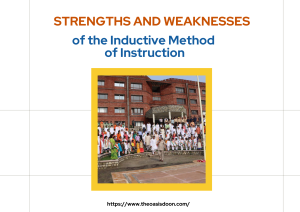
Every teacher has faced that frustrating moment—you’ve explained a concept step-by-step, written it on the board, even repeated it twice, yet your students stare back blankly. Sound familiar? It’s not always because they’re not paying attention; sometimes it’s because the way we teach just isn’t how they learn best.
That’s where the inductive method of teaching comes in. Inductive stands the whole process on its head by teaching students to observe, explore, and infer their own understanding.
It’s a method gaining popularity in progressive classrooms across India, especially in innovative academic hubs like Boys boarding schools in Dehradun, where student-centered learning is taking the spotlight. Let’s break it all down in a way that makes sense—and helps you start using this method right away.
- What Is the Inductive Method of Teaching?
- Why Use the Inductive Approach to Teaching?
- How to Apply the Inductive Technique in Class
- Real-Life Applications Across Subjects
- Strengths and Weaknesses of the Inductive Method of Instruction
- Tips to Make It Work in Any Classroom
- When Should You Not Use the Inductive Method?
- Conclusion
What Is the Inductive Method of Teaching?

The inductive approach to teaching begins with concrete examples and leads students to general principles or laws. Just imagine learning by doing—students are presented with patterns, come up with solutions, or examine real data first, and then they arrive at the rule or theory.
It’s the reverse of the deductive approach, where the teacher presents the rule first and then demonstrates how the rule applies.
Example:
Rather than say to students “All even numbers are divisible by 2,” you present them with a series of numbers and ask:
“What do all these have in common?”
After they discover it themselves, the idea sticks automatically.
Why Use the Inductive Approach to Teaching?

You may be thinking, “Doesn’t this take longer?” Absolutely, sometimes. But the reward is tremendous.
It Makes Learning Stick
When they find things out for themselves, they’re much more likely to recall them.
It Encourages Curiosity
This technique makes class a matter of inquiry—kids get engaged and ask improved questions.
It Builds Thinking Skills
The inductive approach to instruction teaches kids to seek patterns, make conclusions, and use logic.
It Fits Real Life
In real life, individuals learn things through experience. This approach imitates the way we truly acquire knowledge.
How to Apply the Inductive Technique in Class

Here is a step-by-step guide on how to apply the inductive technique of instruction effectively:
1. Select an Appropriate Topic
Select topics in which students can easily identify patterns or behavior. The best examples are:
- Grammar rules (such as article use or verb tense)
- Scientific characteristics (such as conductivity or magnetism)
- Math equations (such as area or volume)
- Social studies topics (such as trade routes or cultural similarities)
2. Collect Real or Fabricated Examples
Rather than telling them the rule, provide examples where the rule is in action.
Example: To instruct the simple past tense, provide students with 5-6 sentences employing past tense verbs and ask them to identify the rule.
3. Ask the Correct Questions
Utilize leading questions that assist students in investigating:
- What do you observe occurring?
- Are there any patterns?
- What could be the cause?
Allow them to think it through in small groups or pairs.
4. Allow Students to Develop the Rule
Once they identify the pattern, have them describe the rule in their own words. This is where they make connections.
5. Offer Practice Opportunities
Now that they know the concept, offer them new exercises or problems to apply the rule they’ve learned.
Real-Life Applications Across Subjects

English (Grammar)
Topic: Use of articles Inductive Activity: Provide sentences like:
- She has a dog.
- I need an umbrella.
- The moon is bright tonight.
Students compare usage and infer when to use “a,” “an,” and “the.”
Math
Topic: Multiples of 5
Activity: Demonstrate numbers such as 10, 15, 20, 25
Ask: What’s the same? Can you predict the next ones?
Science
Topic: States of matter
Utilize water as an example: solid (ice), liquid (water), gas (steam). Have students observe changes and infer states and changes.
Social Studies
Topic: Historical cause and effect
Provide events that caused a war or revolution. Have students determine the similarities in the triggers.
Strengths and Weaknesses of the Inductive Method of Instruction

As with any method, this one is not ideal for all situations. Here’s a brief examination of both pros and cons:
Pros:
- Encourages in-depth understanding
- Increased participation
- Constructs confidence in learners
- Prepares students for actual problem-solving
Cons:
- Time-consuming
- Some students may get lost without direct guidance
- Needs more prep time for the teacher
However, most of these disadvantages are easy to handle with some planning.
Tips to Make It Work in Any Classroom

This is how to make the inductive approach to teaching easier for you and your students:
Start with Small Concepts
Don’t attempt to teach the entire syllabus inductively. Begin with lessons that are straightforward and based on patterns.
Use Peer Discussion
Group work allows students to listen to various opinions and come up with better conclusions.
Guide Without Giving Answers
Your job is to guide, not solve. Don’t be tempted to jump in too quickly.
Use Visuals and Tools
Charts, diagrams, three-dimensional models, or videos help abstract patterns become more intelligible.
When Should You Not Use the Inductive Method?

Certain subjects are too abstract or must have a prerequisite of basic knowledge first. In such situations, it’s acceptable to employ a combination of inductive and deductive instruction. For instance:
- Instruction of a new math formula without any previous related knowledge
- Complicated scientific concepts with no counterpart in the real world
Balance is important. Don’t try to use induction for everything.
Conclusion
Teaching is not necessarily talking. At times, the greatest thing you can do is stand back and allow your students to work it out for themselves. The inductive approach to teaching encourages them to become self-learners, develop problem-solving skills, and become lifelong learners.
So ask yourself next time you are planning a lesson:
“Can they learn this independently with some direction?”
If the answer is yes—try it. Begin with one subject. Observe how interested your students get when they know they have control over learning.



